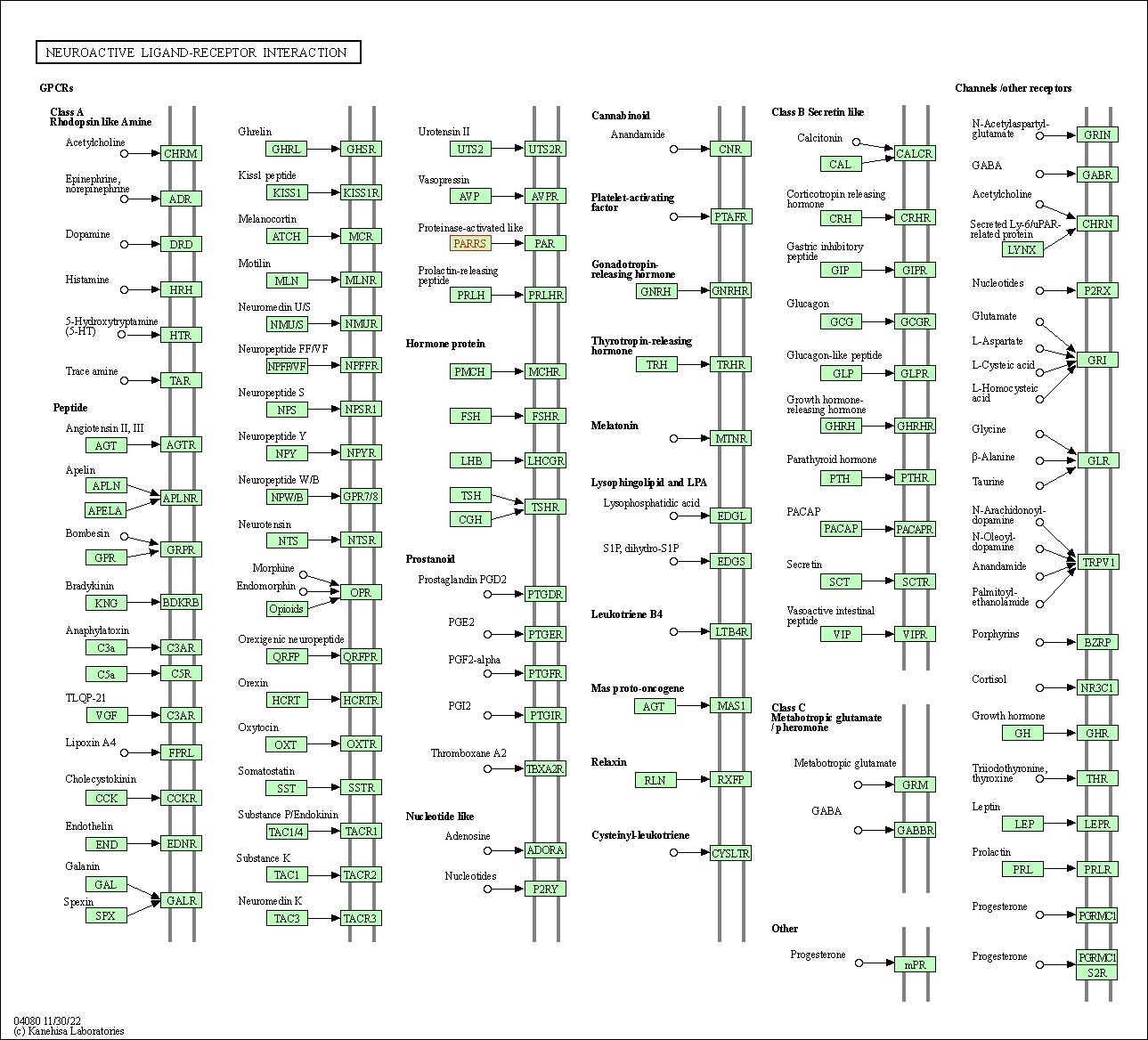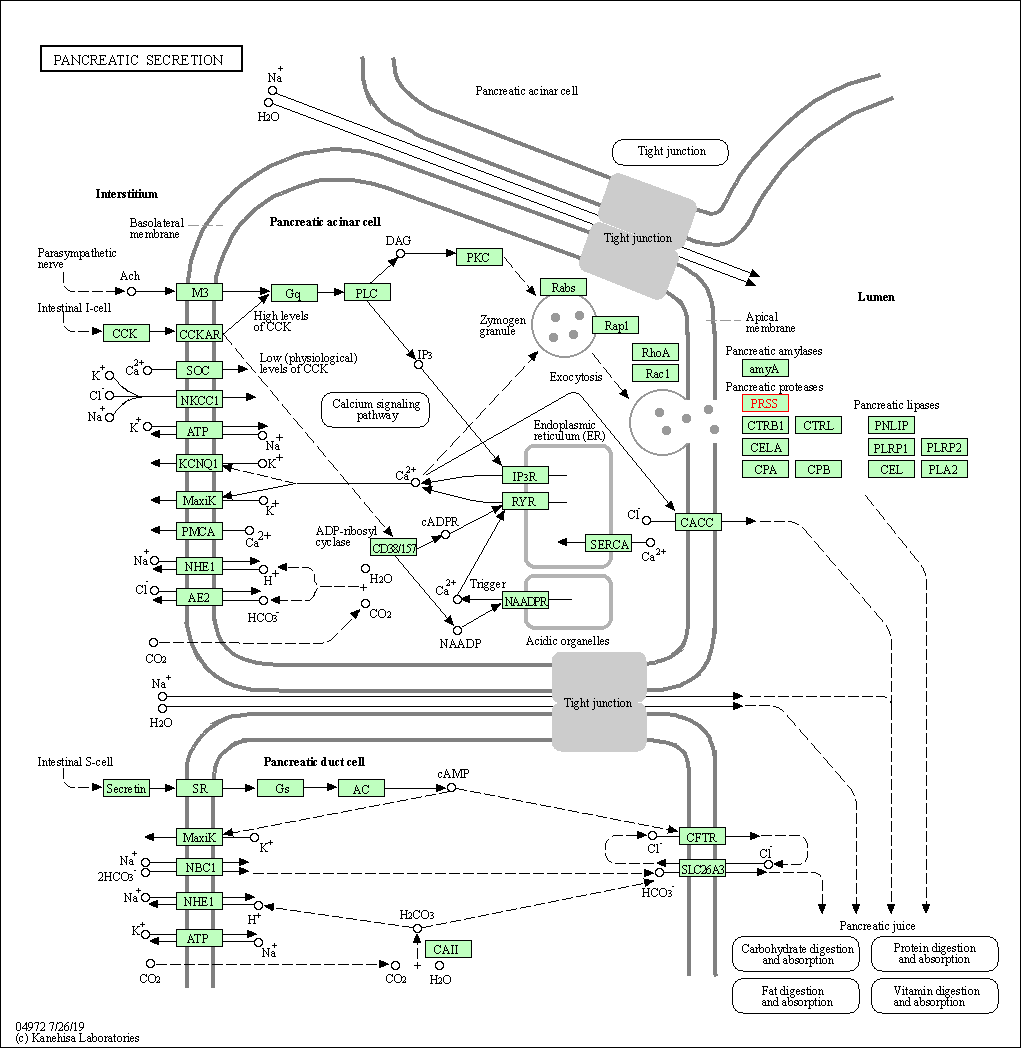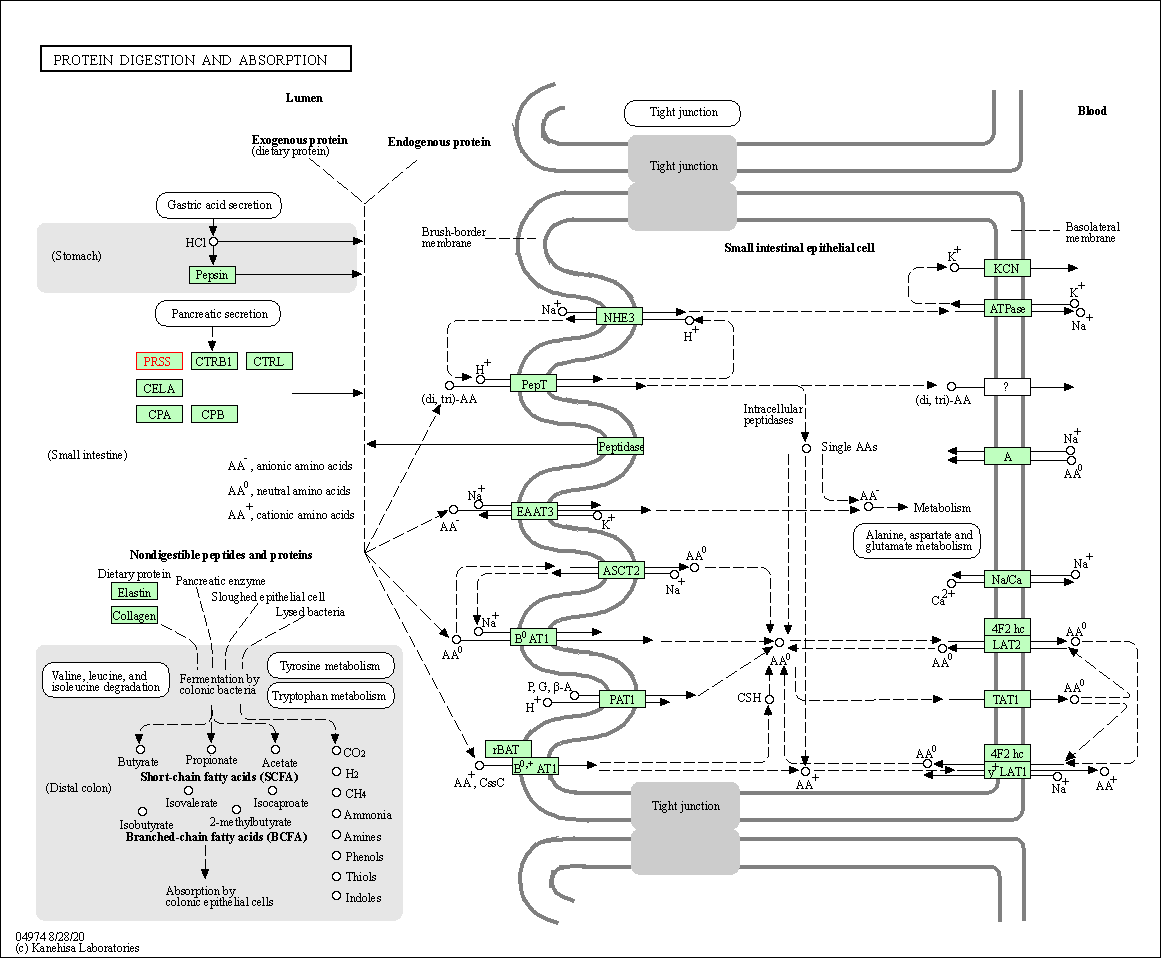Target Information
| Target General Information | Top | |||||
|---|---|---|---|---|---|---|
| Target ID |
T27602
(Former ID: TTDS00282)
|
|||||
| Target Name |
Cationic trypsinogen (PRSS1)
|
|||||
| Synonyms |
Trypsin-1; Trypsin I; TRYP1; TRY1; TRP1; Serine protease 1; Beta-trypsin
Click to Show/Hide
|
|||||
| Gene Name |
PRSS1
|
|||||
| Target Type |
Successful target
|
[1] | ||||
| Disease | [+] 2 Target-related Diseases | + | ||||
| 1 | Mature B-cell lymphoma [ICD-11: 2A85] | |||||
| 2 | Multiple myeloma [ICD-11: 2A83] | |||||
| Function |
Has activity against the synthetic substrates Boc-Phe-Ser-Arg-Mec, Boc-Leu-Thr-Arg-Mec, Boc-Gln-Ala-Arg-Mec and Boc-Val-Pro-Arg-Mec. The single-chain form is more active than the two-chain form against all of these substrates.
Click to Show/Hide
|
|||||
| BioChemical Class |
Peptidase
|
|||||
| UniProt ID | ||||||
| EC Number |
EC 3.4.21.4
|
|||||
| Sequence |
MNPLLILTFVAAALAAPFDDDDKIVGGYNCEENSVPYQVSLNSGYHFCGGSLINEQWVVS
AGHCYKSRIQVRLGEHNIEVLEGNEQFINAAKIIRHPQYDRKTLNNDIMLIKLSSRAVIN ARVSTISLPTAPPATGTKCLISGWGNTASSGADYPDELQCLDAPVLSQAKCEASYPGKIT SNMFCVGFLEGGKDSCQGDSGGPVVCNGQLQGVVSWGDGCAQKNKPGVYTKVYNYVKWIK NTIAANS Click to Show/Hide
|
|||||
| 3D Structure | Click to Show 3D Structure of This Target | PDB | ||||
| HIT2.0 ID | T39YFG | |||||
| Drugs and Modes of Action | Top | |||||
|---|---|---|---|---|---|---|
| Approved Drug(s) | [+] 1 Approved Drugs | + | ||||
| 1 | Bortezomib | Drug Info | Approved | Multiple myeloma | [2], [3] | |
| Clinical Trial Drug(s) | [+] 2 Clinical Trial Drugs | + | ||||
| 1 | Ulinastatin | Drug Info | Phase 3 | Premature labour | [4] | |
| 2 | Alpha-1 antitrypsin | Drug Info | Phase 2 | Coagulation defect | [5] | |
| Discontinued Drug(s) | [+] 3 Discontinued Drugs | + | ||||
| 1 | Dermolastin | Drug Info | Discontinued in Phase 2 | Atopic dermatitis | [6] | |
| 2 | RWJ-56423 | Drug Info | Discontinued in Phase 1 | Asthma | [7] | |
| 3 | Patamostat | Drug Info | Terminated | Hypotension | [8] | |
| Mode of Action | [+] 2 Modes of Action | + | ||||
| Inhibitor | [+] 29 Inhibitor drugs | + | ||||
| 1 | Bortezomib | Drug Info | [1] | |||
| 2 | MELAGATRAN | Drug Info | [9] | |||
| 3 | Dermolastin | Drug Info | [13], [14], [15], [16] | |||
| 4 | RWJ-56423 | Drug Info | [17] | |||
| 5 | BMY-44621 | Drug Info | [18] | |||
| 6 | 1,3-Di-p-tolyl-[1,3]diazetidine-2,4-dione | Drug Info | [20] | |||
| 7 | 1,3-Dibenzyl-[1,3]diazetidine-2,4-dione | Drug Info | [20] | |||
| 8 | 1-(3-Amino-benzyl)-1H-indole-5-carboxamidine | Drug Info | [21] | |||
| 9 | 1-(3-Nitro-benzyl)-1H-indole-5-carboxamidine | Drug Info | [21] | |||
| 10 | 1-Benzyl-1H-indole-5-carboxamidine | Drug Info | [21] | |||
| 11 | 2-(2-Hydroxy-phenyl)-1H-indole-5-carboxamidine | Drug Info | [22] | |||
| 12 | 2-(2-Iodo-phenyl)-benzo[d][1,3]oxazin-4-one | Drug Info | [23] | |||
| 13 | 4-(3,4-Diethoxy-benzylamino)-benzamidine | Drug Info | [24] | |||
| 14 | 4-(4-Benzyloxy-3-methoxy-benzylamino)-benzamidine | Drug Info | [24] | |||
| 15 | 4-(5-Nitro-indol-1-ylmethyl)-benzamidine | Drug Info | [21] | |||
| 16 | 4-Indol-1-ylmethyl-benzamidine | Drug Info | [21] | |||
| 17 | 6-Styryl-naphthalene-2-carboxamidine | Drug Info | [25] | |||
| 18 | 8-Bromo-6-styryl-naphthalene-2-carboxamidine | Drug Info | [25] | |||
| 19 | 8-Furan-3-yl-6-styryl-naphthalene-2-carboxamidine | Drug Info | [25] | |||
| 20 | Benzamidine | Drug Info | [27] | |||
| 21 | CVS-2139 | Drug Info | [28] | |||
| 22 | CVS-2359 | Drug Info | [28] | |||
| 23 | GR-133686 | Drug Info | [29] | |||
| 24 | L-375378 | Drug Info | [30] | |||
| 25 | Macrocyclic tripeptide motif | Drug Info | [31] | |||
| 26 | Piperidine-1-carboxamidine | Drug Info | [32] | |||
| 27 | PMID3514912C9 | Drug Info | [33] | |||
| 28 | RWJ-50353 | Drug Info | [35] | |||
| 29 | Tert-butyloxy carbonyl-D-Phe-pro-Arg-H | Drug Info | [36] | |||
| Modulator | [+] 7 Modulator drugs | + | ||||
| 1 | Ulinastatin | Drug Info | [4] | |||
| 2 | Alpha-1 antitrypsin | Drug Info | [10], [11], [12] | |||
| 3 | Patamostat | Drug Info | [10], [11], [19] | |||
| 4 | ATF-HI-8 | Drug Info | [26] | |||
| 5 | JBP-1 | Drug Info | [10], [11] | |||
| 6 | POP-1 | Drug Info | [10], [11] | |||
| 7 | recAAT, PPL Therapeutics/Bayer | Drug Info | [34] | |||
| Cell-based Target Expression Variations | Top | |||||
|---|---|---|---|---|---|---|
| Cell-based Target Expression Variations | ||||||
| Drug Binding Sites of Target | Top | |||||
|---|---|---|---|---|---|---|
| Ligand Name: Phosphonotyrosine | Ligand Info | |||||
| Structure Description | CRYSTAL STRUCTURE OF HUMAN TRYPSIN 1: UNEXPECTED PHOSPHORYLATION OF TYROSINE 151 | PDB:1TRN | ||||
| Method | X-ray diffraction | Resolution | 2.20 Å | Mutation | No | [37] |
| PDB Sequence |
IVGGYNCEEN
25 SVPYQVSLNS37 GYHFCGGSLI47 NEQWVVSAGH57 CYKSRIQVRL67 GEHNIEVLEG 78 NEQFINAAKI88 IRHPQYDRKT98 LNNDIMLIKL108 SSRAVINARV118 STISLPTAPP 129 ATGTKCLISG140 WGNTASSGAD150 PDELQCLDAP161 VLSQAKCEAS171 YPGKITSNMF 181 CVGFLEGGKD189 SCQGDSGGPV199 VCNGQLQGVV213 SWGDGCAQKN223 KPGVYTKVYN 233 YVKWIKNTIA243 ANS
|
|||||
|
|
||||||
| Ligand Name: Isopropyl dihydrogen phosphate | Ligand Info | |||||
| Structure Description | CRYSTAL STRUCTURE OF HUMAN TRYPSIN 1: UNEXPECTED PHOSPHORYLATION OF TYROSINE 151 | PDB:1TRN | ||||
| Method | X-ray diffraction | Resolution | 2.20 Å | Mutation | No | [37] |
| PDB Sequence |
IVGGYNCEEN
25 SVPYQVSLNS37 GYHFCGGSLI47 NEQWVVSAGH57 CYKSRIQVRL67 GEHNIEVLEG 78 NEQFINAAKI88 IRHPQYDRKT98 LNNDIMLIKL108 SSRAVINARV118 STISLPTAPP 129 ATGTKCLISG140 WGNTASSGAD150 PDELQCLDAP161 VLSQAKCEAS171 YPGKITSNMF 181 CVGFLEGGKD189 SCQGDSGGPV199 VCNGQLQGVV213 SWGDGCAQKN223 KPGVYTKVYN 233 YVKWIKNTIA243 ANS
|
|||||
|
|
||||||
| Click to View More Binding Site Information of This Target with Different Ligands | ||||||
| Different Human System Profiles of Target | Top |
|---|---|
|
Human Similarity Proteins
of target is determined by comparing the sequence similarity of all human proteins with the target based on BLAST. The similarity proteins for a target are defined as the proteins with E-value < 0.005 and outside the protein families of the target.
A target that has fewer human similarity proteins outside its family is commonly regarded to possess a greater capacity to avoid undesired interactions and thus increase the possibility of finding successful drugs
(Brief Bioinform, 21: 649-662, 2020).
Human Tissue Distribution
of target is determined from a proteomics study that quantified more than 12,000 genes across 32 normal human tissues. Tissue Specificity (TS) score was used to define the enrichment of target across tissues.
The distribution of targets among different tissues or organs need to be taken into consideration when assessing the target druggability, as it is generally accepted that the wider the target distribution, the greater the concern over potential adverse effects
(Nat Rev Drug Discov, 20: 64-81, 2021).
Human Pathway Affiliation
of target is determined by the life-essential pathways provided on KEGG database. The target-affiliated pathways were defined based on the following two criteria (a) the pathways of the studied target should be life-essential for both healthy individuals and patients, and (b) the studied target should occupy an upstream position in the pathways and therefore had the ability to regulate biological function.
Targets involved in a fewer pathways have greater likelihood to be successfully developed, while those associated with more human pathways increase the chance of undesirable interferences with other human processes
(Pharmacol Rev, 58: 259-279, 2006).
Human Similarity Proteins
Human Tissue Distribution
Human Pathway Affiliation
|
|
|
There is no similarity protein (E value < 0.005) for this target
|
|
Note:
If a protein has TS (tissue specficity) scores at least in one tissue >= 2.5, this protein is called tissue-enriched (including tissue-enriched-but-not-specific and tissue-specific). In the plots, the vertical lines are at thresholds 2.5 and 4.
|
| KEGG Pathway | Pathway ID | Affiliated Target | Pathway Map |
|---|---|---|---|
| Neuroactive ligand-receptor interaction | hsa04080 | Affiliated Target |

|
| Class: Environmental Information Processing => Signaling molecules and interaction | Pathway Hierarchy | ||
| Pancreatic secretion | hsa04972 | Affiliated Target |

|
| Class: Organismal Systems => Digestive system | Pathway Hierarchy | ||
| Protein digestion and absorption | hsa04974 | Affiliated Target |

|
| Class: Organismal Systems => Digestive system | Pathway Hierarchy | ||
| Chemical Structure based Activity Landscape of Target | Top |
|---|---|
| Drug Property Profile of Target | Top | |
|---|---|---|
| (1) Molecular Weight (mw) based Drug Clustering | (2) Octanol/Water Partition Coefficient (xlogp) based Drug Clustering | |
|
|
||
| (3) Hydrogen Bond Donor Count (hbonddonor) based Drug Clustering | (4) Hydrogen Bond Acceptor Count (hbondacc) based Drug Clustering | |
|
|
||
| (5) Rotatable Bond Count (rotbonds) based Drug Clustering | (6) Topological Polar Surface Area (polararea) based Drug Clustering | |
|
|
||
| "RO5" indicates the cutoff set by lipinski's rule of five; "D123AB" colored in GREEN denotes the no violation of any cutoff in lipinski's rule of five; "D123AB" colored in PURPLE refers to the violation of only one cutoff in lipinski's rule of five; "D123AB" colored in BLACK represents the violation of more than one cutoffs in lipinski's rule of five | ||
| Co-Targets | Top | |||||
|---|---|---|---|---|---|---|
| Co-Targets | ||||||
| Target Poor or Non Binders | Top | |||||
|---|---|---|---|---|---|---|
| Target Poor or Non Binders | ||||||
| Target Profiles in Patients | Top | |||||
|---|---|---|---|---|---|---|
| Drug Resistance Mutation (DRM) | ||||||
| Target Affiliated Biological Pathways | Top | |||||
|---|---|---|---|---|---|---|
| KEGG Pathway | [+] 4 KEGG Pathways | + | ||||
| 1 | Neuroactive ligand-receptor interaction | |||||
| 2 | Pancreatic secretion | |||||
| 3 | Protein digestion and absorption | |||||
| 4 | Influenza A | |||||
| Reactome | [+] 2 Reactome Pathways | + | ||||
| 1 | Activation of Matrix Metalloproteinases | |||||
| 2 | Cobalamin (Cbl, vitamin B12) transport and metabolism | |||||
| WikiPathways | [+] 1 WikiPathways | + | ||||
| 1 | Activation of Matrix Metalloproteinases | |||||
| Target-Related Models and Studies | Top | |||||
|---|---|---|---|---|---|---|
| Target Validation | ||||||
| References | Top | |||||
|---|---|---|---|---|---|---|
| REF 1 | Characterization of a class of peptide boronates with neutral P1 side chains as highly selective inhibitors of thrombin. J Med Chem. 1995 Apr 28;38(9):1511-22. | |||||
| REF 2 | URL: http://www.guidetopharmacology.org Nucleic Acids Res. 2015 Oct 12. pii: gkv1037. The IUPHAR/BPS Guide to PHARMACOLOGY in 2016: towards curated quantitative interactions between 1300 protein targets and 6000 ligands. (Ligand id: 6391). | |||||
| REF 3 | New developments in immunosuppressive therapy for heart transplantation. Expert Opin Emerg Drugs. 2009 Mar;14(1):1-21. | |||||
| REF 4 | Intravenous administration of ulinastatin (human urinary trypsin inhibitor) in severe sepsis: a multicenter randomized controlled study. Intensive Care Med. 2014 Jun;40(6):830-8. | |||||
| REF 5 | Technology evaluation: transgenic alpha-1-antitrypsin (AAT), PPL therapeutics. Curr Opin Mol Ther. 2000 Apr;2(2):199-204. | |||||
| REF 6 | Trusted, scientifically sound profiles of drug programs, clinical trials, safety reports, and company deals, written by scientists. Springer. 2015. Adis Insight (drug id 800018071) | |||||
| REF 7 | Potent, small-molecule inhibitors of human mast cell tryptase. Antiasthmatic action of a dipeptide-based transition-state analogue containing a benzothiazole ketone. J Med Chem. 2003 Aug 28;46(18):3865-76. | |||||
| REF 8 | Trusted, scientifically sound profiles of drug programs, clinical trials, safety reports, and company deals, written by scientists. Springer. 2015. Adis Insight (drug id 800003114) | |||||
| REF 9 | Orally active thrombin inhibitors. Part 1: optimization of the P1-moiety. Bioorg Med Chem Lett. 2006 May 15;16(10):2641-7. | |||||
| REF 10 | US patent application no. 2012,0251,516, PHARMACEUTICAL COMPOSITION FOR TREATING CANCER COMPRISING TRYPSINOGEN AND/OR CHYMOTRYPSINOGEN AND AN ACTIVE AGENT SELECTED FROM A SELENIUM COMPOUND, A VANILLOID COMPOUND AND A CYTOPLASMIC GLYCOLYSIS REDUCTION AGENT. | |||||
| REF 11 | EP patent application no. 2490711, A pharmaceutical composition for treating cancer comprising trypsinogen and/or chymotrypsinogen and an active agent selected from a selenium compound, a vanilloid compound and a cytoplasmic glycolysis reduction agent). | |||||
| REF 12 | Expression of human alpha 1 antitrypsin in transgenic sheep. Cytotechnology. 1992;9(1-3):77-84. | |||||
| REF 13 | Arriva-ProMetic recombinant alpha 1-antitrypsin (rAAT) moves into the clinic for dermatology applications. ProMetic Life Sciences. 2009. | |||||
| REF 14 | rAAt (inhaled) Arriva/Hyland Immuno. Curr Opin Mol Ther. 2006 Feb;8(1):76-82. | |||||
| REF 15 | Optimization of the bioprocessing conditions for scale-up of transient production of a heterologous protein in plants using a chemically inducible viral amplicon expression system. Biotechnol Prog. 2009 May-Jun;25(3):722-34. | |||||
| REF 16 | Bioreactor strategies for improving production yield and functionality of a recombinant human protein in transgenic tobacco cell cultures. Biotechnol Bioeng. 2009 Feb 1;102(2):508-20. | |||||
| REF 17 | Inhibitors of serine proteases as potential therapeutic agents: the road from thrombin to tryptase to cathepsin G. J Med Chem. 2004 Feb 12;47(4):769-87. | |||||
| REF 18 | Design and synthesis of conformationally constrained arginal thrombin inhibitors, Bioorg. Med. Chem. Lett. 7(17):2205-2210 (1997). | |||||
| REF 19 | Effects of E-3123, a new protease inhibitor, on several protease activities and on experimental acute pancreatitis. Nihon Yakurigaku Zasshi. 1988 May;91(5):285-93. | |||||
| REF 20 | Inhibition of serine proteases: activity of 1,3-diazetidine-2,4-diones. Bioorg Med Chem Lett. 2001 Jul 9;11(13):1691-4. | |||||
| REF 21 | Aromatic amidines: comparison of their ability to block respiratory syncytial virus induced cell fusion and to inhibit plasmin, urokinase, thrombin... J Med Chem. 1983 Feb;26(2):294-8. | |||||
| REF 22 | Development of serine protease inhibitors displaying a multicentered short (<2.3 A) hydrogen bond binding mode: inhibitors of urokinase-type plasmi... J Med Chem. 2001 Aug 16;44(17):2753-71. | |||||
| REF 23 | 2-amino-4H-3,1-benzoxazin-4-ones as inhibitors of C1r serine protease. J Med Chem. 1998 Mar 26;41(7):1060-7. | |||||
| REF 24 | Design of selective phenylglycine amide tissue factor/factor VIIa inhibitors. Bioorg Med Chem Lett. 2005 Feb 1;15(3):817-22. | |||||
| REF 25 | Naphthamidine urokinase plasminogen activator inhibitors with improved pharmacokinetic properties. Bioorg Med Chem Lett. 2005 Jan 3;15(1):93-8. | |||||
| REF 26 | Inhibitory effect of a conjugate between human urokinase and urinary trypsin inhibitor on tumor cell invasion in vitro. J Biol Chem. 1995 Apr 7;270(14):8361-6. | |||||
| REF 27 | How many drug targets are there Nat Rev Drug Discov. 2006 Dec;5(12):993-6. | |||||
| REF 28 | Non-covalent thrombin inhibitors featuring P(3)-heterocycles with P(1)-monocyclic arginine surrogates. Bioorg Med Chem Lett. 2002 Apr 22;12(8):1203-8. | |||||
| REF 29 | 5,5-trans lactone-containing inhibitors of serine proteases: identification of a novel, acylating thrombin inhibitor. Bioorg Med Chem Lett. 1998 Nov 3;8(21):2955-60. | |||||
| REF 30 | Small, low nanomolar, noncovalent thrombin inhibitors lacking a group to fill the 'distal binding pocket'. Bioorg Med Chem Lett. 2003 Jan 20;13(2):161-4. | |||||
| REF 31 | Novel thrombin inhibitors that are based on a macrocyclic tripeptide motif, Bioorg. Med. Chem. Lett. 6(24):2947-2952 (1996). | |||||
| REF 32 | GRID/CPCA: a new computational tool to design selective ligands. J Med Chem. 2000 Aug 10;43(16):3033-44. | |||||
| REF 33 | Synthesis and inhibition of human acrosin and trypsin and acute toxicity of aryl 4-guanidinobenzoates. J Med Chem. 1986 Apr;29(4):514-9. | |||||
| REF 34 | Reduction in neutrophil elastase concentration by recombinant alphal-antitrypsin (recAAT) does not alter bacterial loading in the sputum of cystic ... Br J Biomed Sci. 2004;61(3):146-7. | |||||
| REF 35 | In-depth study of tripeptide-based alpha-ketoheterocycles as inhibitors of thrombin. Effective utilization of the S1' subsite and its implications ... J Med Chem. 2005 Mar 24;48(6):1984-2008. | |||||
| REF 36 | Structure-activity study of tripeptide thrombin inhibitors using alpha-alkyl amino acids and other conformationally constrained amino acid substitu... J Med Chem. 1995 Oct 27;38(22):4446-53. | |||||
| REF 37 | Crystal structure of human trypsin 1: unexpected phosphorylation of Tyr151. J Mol Biol. 1996 Jun 28;259(5):995-1010. | |||||
If You Find Any Error in Data or Bug in Web Service, Please Kindly Report It to Dr. Zhou and Dr. Zhang.

